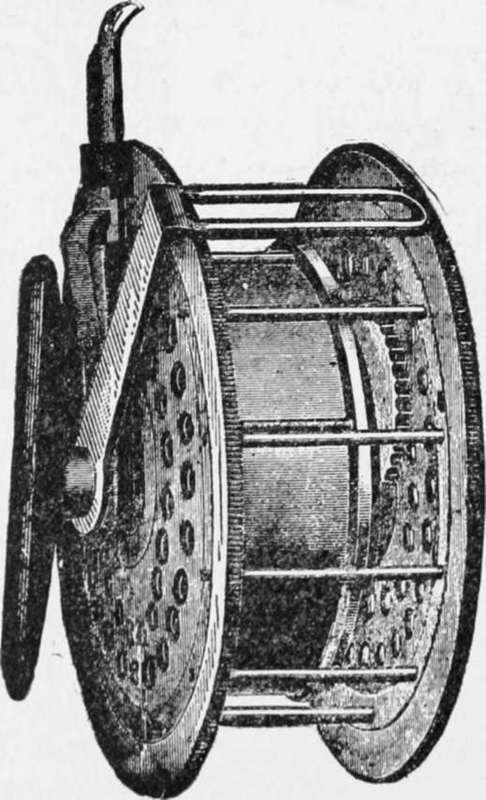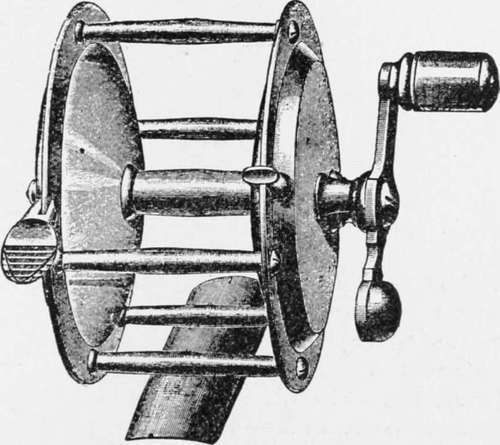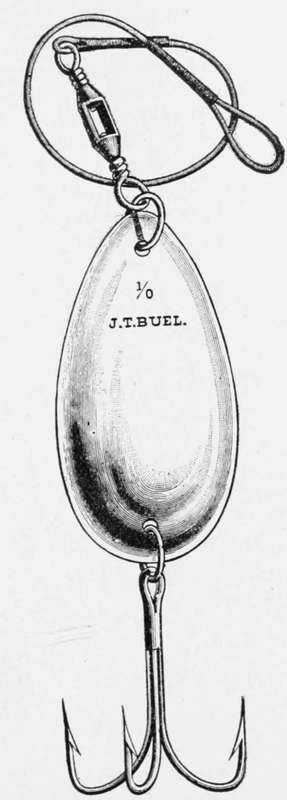Dressings Of Salmon Flies. Continued
Description
This section is from the book "American Game Fishes", by W. A. Perry. Also available from Amazon: American Game Fishes: Their Habits, Habitat, and Peculiarities; How, When, and Where to Angle for Them.
Dressings Of Salmon Flies. Continued
Sides
Jungle fowl.
Horns
Blue macaw.
Head
Black wool.
Black Dose
Tag
Silver twist and very light orange silk.
Tail
A topping, teal and ibis.
Body
Two or three turns of light blue seal's fur and black seal's fur.
Ribs
Silver tinsel.
Hackle
Natural black, along the back seal's fur.
Throat
A very light plum-claret hackle.
Wings
Double tippets, veiled with teal, light-mottled turkey, golden pheasant tail, unbarred summer duck, peacock herl, and mallard,strands of ibis and parrot for small patterns; swan (dyed the same two colors), for large sizes.
Horns
Blue macaw.
Head
Black herl.
Taite's Fancy
Tag
Silver twist and blue silk.
Tail
A topping and toucan.
Butt
Black herl.
Body
Silver tinsel (flat).
Ribs
Silver tinsel (oval).
Hackle
Claret, from the second turn of tinsel.
Throat
Blue hackle.
Wings
Hen pheasant tail, peacock Wing, swan (dyed very dark red orange), golden pheasant tail, and two strips of mallard above.
Horns
Blue macaw.
Head
Black herl.
Lion
Tag
Silver twist and yellow silk.
Tail
A topping.
Butt
Black herl.
Body
Silver tinsel (flat), ribbed with silver tinsel (oval), about one-fifth part being left at the shoulder for dark scarlet seal's fur, well picked out.
Hackle
Natural black.
Throat
Gallina.
Wings
Commencing with a few fibers of golden pheasant tippet, sword feather of the golden pheasant, and peacock herl. yellow macaw, red macaw, bustard, golden pheasant tail, teal, gallina, with two strips of mallard above, and a topping.
Sides
Jungle fowl.
Horns
Blue macaw.
Head
Black Berlin wool.
The Leader (B)
A few words in the heading "Gut" have already been said in regard to the leader or length of gut which interposes between the fly and the reel-line. It need only be added that its selection as to gauge should be dependent on the state of the water and the size of the fish expected to be taken. If the water be low and clear a fine leader is manifestly necessary. If it is roily, and the fish run large, a thicker one is advisable. It should at least be as long as the rod.
The Reel-Line (C)
It is almost impossible to single out the best makes of line. My personal preference is for those made by Mr. E. J. Martin, of Rockville, Conn., and for the Acme copper gimp-centered line of Foster Bros., Ashborne, Derbyshire, England. The latter is heavy without bulk, and is exceedingly easy to "lay out" on the surface of the water.
The Reel (D)
So many splendid reels are now on the market, that the task of selection is almost invidious. The diagrams show those I use myself. Fig. 33 is the Automatic. This operates automatically when a fish is hooked and it is desired to reel in. The whole operation is performed by one hand. The little finger bears on the brake, and the reel begins to wind in; and the fish has a spring operating against him ;ill the while. Fig. 34

Fig. 33.
is that patented by Mr. Chubb, of Post Mills, Vt. It is termed the "Henshall-van Antwerp," and for all-round fly fishing cannot be surpassed. Of course for Salmon a larger reel is necessary.
The Fly-Book (E)
This is a consideration of some importance, and the number of different patterns in existence proves that there are differences of opinion as to the best. The gut-snell of fly-books in this country is for some reason fixed at four and one-half inches, and the ingenuity of inven tion has been exercised over the discovery of some device which shall retain the snell straight, before and after use. The most efficient, as far as I have been able to examine- and I have seen all-is the Bray arrangement. The hooks are hung over a bar, and then brought down between the close helices of a spiral wire fixed crosswise in the book. The same idea appears in another device of later design, in that separate rings are crowded together on a rod confined at the ends. Both are good, but the "Bray" arrangement is best.

Fig. 34.
The fly-book of the future will not be arbitrarily arranged for the four-and-one-half-inch snell, for the reason that the snell of the future will probably be as long as possible without a knot. When the fish of this country become educated to the height of culture exhibited by their European cousins, the farther the loop of the snell is from the hook the better. There is an inevitably bad feature of all the fly-books, as at present made, also in that they crush the fly, and if it should be of the "roofed" or flat-winged species it is entirely put out of shape every time. I am getting up a book which isn't a book, for it is made of tin or zinc. The flies extend beyond the top in a kind of wooden case, and each one can be drawn out without disturbing its fellow. There is nothing so attractive to a shy fish as a brand-new fly, floating with dry buoyancy along the crystal stream, with the sunbeams filtering through its lace-like wings, and glinting on its gay-colored body and opalescent hackle.
I am also perfecting a fly-fisher's hat, the description of which may thus be shadowed forth: A hat having a belt-attachment instead of band encircling it, with books, etc., for the attachment of flies and leaders. Under the helmet-shaped peak, fore and after, are pockets for spare leaders, etc., and on each side an attachment for spare flies. If the angler wants to go to church in this hat he can do so, after removing the attachments, leaving it a respectable-looking chapeau enough-anyhow, good enough for a truth-perverting angler.
[For "Rods and Rod-making," see chapter under that heading]

Fig. 35.
Continue to:
